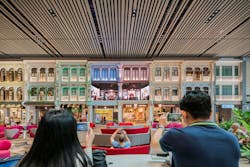Audiovisual Experiences Benefit Travelers and Airports
Non-aeronautical revenue streams continue to be of vital importance to an airport’s bottom line, accounting for 46% of the total operating revenue for all U.S. airports, according to Airports Council International. However, roughly 41% of that revenue comes from airport-offered parking and ground transportation, which are under threat from transportation network companies (TNCs), such as Uber and Lyft, not to mention the looming specter of autonomous vehicles.
To help mitigate against this risk, forward-looking airports are increasingly focusing on the airport terminal experience to cultivate relaxing environments for their travelers. Such efforts dovetail nicely with the results of a recent DKMA Aviation study, which found that happy, relaxed airport customers are twice as likely to shop and will typically spend 7% more on retail and 10% more on duty-free goods — a boost to airports’ non-aeronautical revenue streams at a time when the industry needs it most.
Leading airports such as Charlotte Douglas International Airport, LAX and Singapore’s Changi Airport have recently leveraged cutting-edge audiovisual technologies to enhance the terminal experience, cultivate traveler relaxation, and, by extension, help bolster non-aeronautical revenue.
Build It and They Will Relax
Relaxation is not typically a feeling associated with time spent in an airport. For years, the airport experience has been about long, slow-moving lines, anxiety-ridden security screenings, and delays suffered at nondescript gates. But entertaining and engaging terminal experiences that feature cutting-edge digital and audiovisual technologies are helping airports reimagine the passenger journey.
At the aforementioned Charlotte Douglas International Airport, a 140-foot long display screen in the airport’s newly refurbished Concourse A features renown digital artist Refik Anadol’s unique “data sculptures” that turn invisible patterns of data into captivating, relaxing and ever-changing artistic content. Two more large screens (approximately 40-foot and 28-foot long) also display Refik’s work and all three are visible from outside the airport, with the effect of creating a welcoming experience.
At Singapore’s Changi Airport, a massive 230-foot long by 33-foot high LED display features stunning 3D visuals produced by audiovisual design firm Moment Factory. The display is located in a security screening area, which has turned the normally tedious screening process into a far more engaging and less stressful experience.
The idea behind both AV installations is to make travel frictionless, speedier and more enjoyable for travelers, giving them more time and energy to explore the rest of the airport. And ultimately calm, relaxing environments will most certainly encourage customers to use the airport in the future, rather than choosing other airports or modes of transportation.
Airports are also using audiovisual technology more often and creatively as an effective advertising platform. Operators are replacing static messages and images with attention-grabbing digital content that can respond to consumers' mobile phone activity or shared information networks. One example can be found at London’s Heathrow Airport, as smaller-screened digital billboards used by the U.K.'s global business publication, the Financial Times, target specific passengers flying to six pre-selected U.S. cities. The technology taps into Heathrow's flight data via an application programming interface (API) to target only these passengers with ads relevant to the locations they are traveling to.
At yet another busy U.K. airport, London’s Stansted Airport, officials there recently deployed a 39-foot long large-scale curved visualization system. The display is not only helping travelers find their flight information, but the brightness and size of the display also provides a dynamic tool for advertisers to get their brand message across in a way that is highly engaging for customers.
“Airport advertising creates significant brand awareness and sales by helping advertisers reach highly coveted audiences such as the affluent frequent flyer and the key business decision makers around the world,” said Morten Gotterup, President of Clear Channel Airports, which recently concluded a study that revealed airport advertising is a particularly effective means of delivering brand messaging to consumers.
A Constant Conversation
Customer experience can be difficult to define, but easy to recognize when it’s missing -- and truly understanding the frustrations passengers face requires a two-way dialogue.
“We say apathy is actually our worst enemy,” said Andy Merkin, Producer for Moment Factory. “We would rather have somebody hate something, because then they feel an emotion. It is about engaging customers and listening to them, it's a constant conversation that you're having with your passengers.”
Audiovisual solutions can play a major role in improving the airport experience. Whether it’s a massive video wall with content that amazes and amuses weary travelers; a clear, informative LED display with an engaging and targeted advertising message; or a new audio technology that delivers soothing and easy-to-understand instructions, AV technology has a positive impact on the nature of air travel.
Brad Grimes is Senior Director of Communications for AVIXA™, the Audiovisual and Integrated Experience Association. AVIXA represents the $178 billion global commercial AV industry and produces InfoComm trade shows around the world. For more information, visit www.avixa.org/transportationAV.
About the Author

